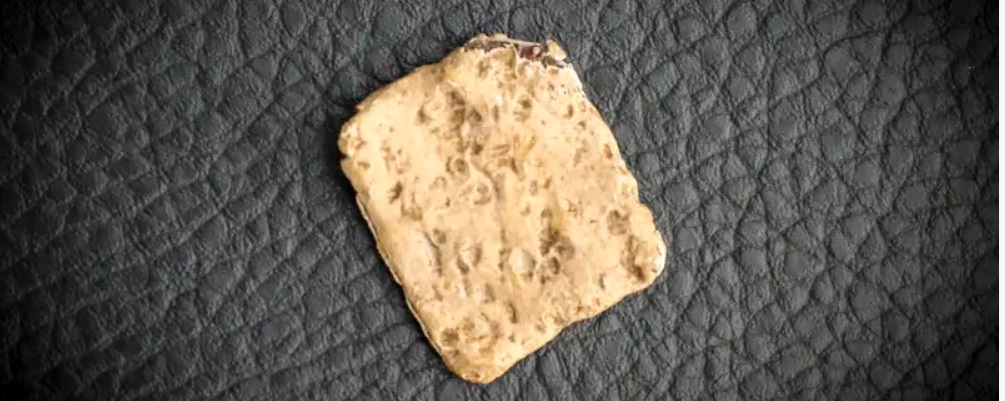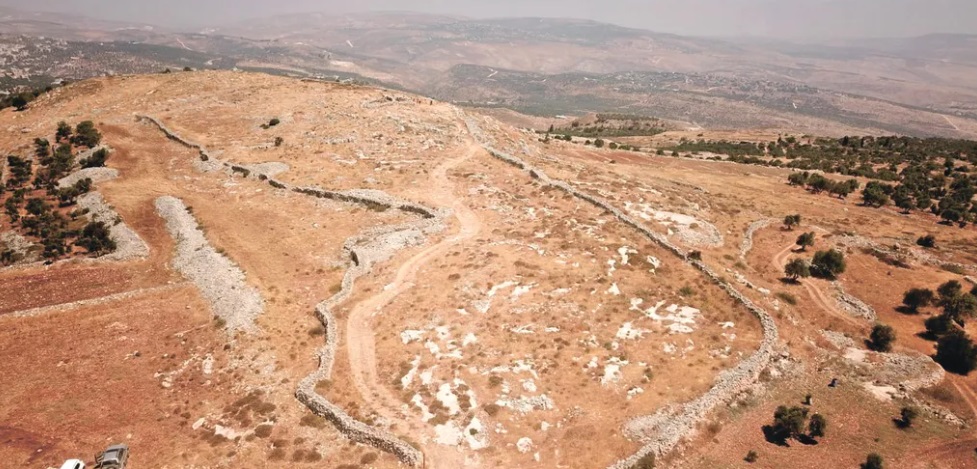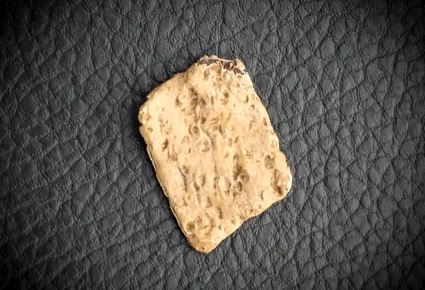Researchers say they have deciphered a 3,000-year-old formulaic curse inscription recovered on a small, folded lead amulet found on Mount Ebal, making it the oldest proto-Hebrew text ever found in Israel. The Mount Ebal discovery predates any previously known Hebrew inscription by at least 200 years, and possibly longer.
The object in question is a little folded lead tablet. First recovered on Mount Ebal near Shechem in the 1982 by archaeologist Adam Zertal, though at the time Zertal did not know what he had found. The little tablet was easily overlooked in the detritus Zertal was removing from the site of an ancient altar on Ebal’s east side, as it was extremely small: only 2×2 cm. (0.3 cm. thick when folded); the thickness of the single lead strip itself merely measures 0.4 mm. The tablet was thus mixed in with the refuse from the 1982 excavation and filed away.

The lead tablet was not properly discovered until 2019 when Scott Stripling of the Archaeological Studies Institute in Katy, Texas, sifted the discarded material from Zertal’s excavation and discovered it. The folded tablet could not be opened without damaging it. It is possible, however, to read the contents of such items using a process called X-ray tomographic imaging, a process consisting of directing X-rays at an object from multiple orientations and measuring the decrease in intensity along a series of linear paths. The imaging (carried out under the supervision of a multinational team of American, German, Czech, and Israeli researchers) revealed a hidden text containing an ancient Hebrew inscription. The inscription was a formulaic curse written in the oldest known version of Hebrew and containing the divine name YHWH.
Before we examine the contents of the tablet, let us review the significance of a cursing tablet being found on Mount Ebal.
Mount Ebal
Mount Ebal is an extremely important site in Old Testament history. In the Book of Deuteronomy, God commanded Moses, “And when the Lord your God brings you into the land which you are entering to take possession of it, you shall set the blessing on Mount Gerizim and the curse on Mount Ebal” (Deut. 11:29). A little later, the command is given to build an altar on Mount Ebal. This is in preparation for the uttering of the blessings and curses of the covenant. Deuteronomy 27 explains the arrangement:
Moses charged the people as follows: When you have crossed over the Jordan, these shall stand on Mount Gerizim for the blessing of the people: Simeon, Levi, Judah, Issachar, Joseph, and Benjamin. And these shall stand on Mount Ebal for the curse: Reuben, Gad, Asher, Zebulun, Dan, and Naphtali. Then the Levites shall declare in a loud voice to all the Israelites:
“Cursed be anyone who makes an idol or casts an image, anything abhorrent to the Lord, the work of an artisan, and sets it up in secret.” All the people shall respond, saying, “Amen!”
“Cursed be anyone who dishonors father or mother.” All the people shall say, “Amen!”
“Cursed be anyone who moves a neighbor’s boundary marker.” All the people shall say, “Amen!”
“Cursed be anyone who misleads a blind person on the road.” All the people shall say, “Amen!”
“Cursed be anyone who deprives the alien, the orphan, and the widow of justice.” All the people shall say, “Amen!”
“Cursed be anyone who lies with his father’s wife, because he has violated his father’s rights.” All the people shall say, “Amen!”
“Cursed be anyone who lies with any animal.” All the people shall say, “Amen!”
“Cursed be anyone who lies with his sister, whether the daughter of his father or the daughter of his mother.” All the people shall say, “Amen!”
“Cursed be anyone who lies with his mother-in-law.” All the people shall say, “Amen!”
“Cursed be anyone who strikes down a neighbor in secret.” All the people shall say, “Amen!”
“Cursed be anyone who takes a bribe to shed innocent blood.” All the people shall say, “Amen!”
“Cursed be anyone who does not uphold the words of this law by observing them.” All the people shall say, “Amen!” (Deut. 27:11-26)
The following chapter likewise describes how the other half of the tribes would stand upon Mount Gerizim opposite Mount Ebal and pronounce blessings. Moses, of course, did not enter into the promised land. These things were carried out under Joshua and described in Joshua 8:
And all Israel, sojourner as well as homeborn, with their elders and officers and their judges, stood on opposite sides of the ark before the Levitical priests who carried the ark of the covenant of the Lord, half of them in front of Mount Gerizim and half of them in front of Mount Ebal, as Moses the servant of the Lord had commanded at the first, that they should bless the people of Israel. And afterward he read all the words of the law, the blessing and the curse, according to all that is written in the book of the law. (Joshua 8:33-34)
The Old Testament records that the tribes of Simeon, Levi, Judah, Issachar, Joseph, and Benjamin were to stand of Gerizim, while those of Reuben, Dan, Gad, Asher, Zebulun, and Naphtali were to remain on Ebal. The reason for this particular distribution is uncertain. It seems, however, that the association of cursing with Ebal and blessing with Gerizim was likely related to the geogrpahy of the mountains: Mount Gerizim is green and flowering whereas Mount Ebal is barren. This is a fitting representation of the curses and blessings contained in the Law of Moses.
Before returning to the tablet, let us recall that the school of Higher Criticism considers this entire story to be a pious myth. Exemplified by the scholars of the Documentary Hypothesis school, the Exodus stories are narratives constructed during the Babylonian Exile as an expression of Israelite efforts to create a national origin story for their people. Scholars of the Higher Criticism school deny that the Israelites as a distinct people even existed in the second millennium B.C., arguing that they they were originally a subgroup of the Canaanites who split from the Canaanite culture sometime after 1,000 B.C. The Hebrew language, as well, was argued to be of later origin, with the first paleo-Hebrew inscriptions dated to the 900s B.C.

“You are cursed by the God YHWH”
The tomographic imaging revealed the clear presence of 48 letters uttering curses in the name of God. The word “curse” appears 10 times, and the divine name YHWH appears twice. The full inscription rendered in English reads:
“Cursed, cursed, cursed—cursed by the God YHWH. You will die cursed. Cursed you will surely die. Cursed by YHWH—cursed, cursed, cursed.”
Such cursing tablets are common in ancient cultures and are known as a defixio. A cursing prayer would be written upon the little lead tablet. They were then often rolled, folded, or pierced with nails, and the tablets were then usually placed beneath the ground: buried, thrown into wells or pools, or sometimes nailed to the walls of temples. Given the site of an ancient Israelite altar on Mount Ebal and its association with cursing, the locale may have been a place Israelites visited to curse their enemies, using a cursing tablet like the one discovered by Zertal. The curse formula on the Ebal tablet uses chiastic parallelism, a literary form common among the ancient Israelites where two or more consecutive phrases repeat the same grammatical structure with just a few words changed each time.
The Mount Ebal cursing tablet has been dated to the Late Bronze Age. Gershon Galil, a researcher at in Jewish history and biblical studies at the University of Haifa who worked on the project, has conservatively dated the tablet to the 13th century B.C. but admits it may be older.
A peer-reviewed paper on the finding is forthcoming. Assuming the findings are accurate, several implications would follow:
First, the presence of a population speaking and writing paleo-Hebrew existed in northern Israel from at least the 13th millennium B.C., centuries earlier than some scholars had argued was possible.
Second, the texts of Deuteronomy and Joshua describing Mount Ebal as a site of ritual cursing can not be written off as part of a national mythos with no historical underpinning. There clearly was an association of ritual cursing with Mount Ebal dating back to the time of the Conquest.
Third, the Israelite God YHWH was being worshiped in Israel in the 13th century B.C.
As with most discoveries of this nature, there is controversy surrounding the tablet; a contrarian interpretation of the findings can be read here, which debates both the dating and the inscription itself. It is important to note that the finds have not yet been Carbon-14 dated, and detailed photographs of the text have not been released. Until the peer-reviewed study is published later this year (2023) we must suspend judgment for a time. This article will be updated as more information becomes available.
Sources:
Judith Sudilovsky, “Researchers decipher oldest known Hebrew inscription on ‘cursed’ tablet,” The Jerusalem Post, Mar. 26, 2022, available online at https://www.jpost.com/archaeology/article-702271
Judy Siegel-Itzkovitch, “Ancient tablet found on Mount Ebal predates known Hebrew inscriptions,” The Jerusalem Post, May 15, 2023. Available online at: https://www.jpost.com/archaeology/article-743039
Phillip Campbell, “The Cursing Tablet of Mount Ebal,” Unam Sanctam Catholicam. May 20, 2023. Available online at: https://www.unamsanctamcatholicam.com/2023/05/the-cursing-tablet-of-mount-ebal

